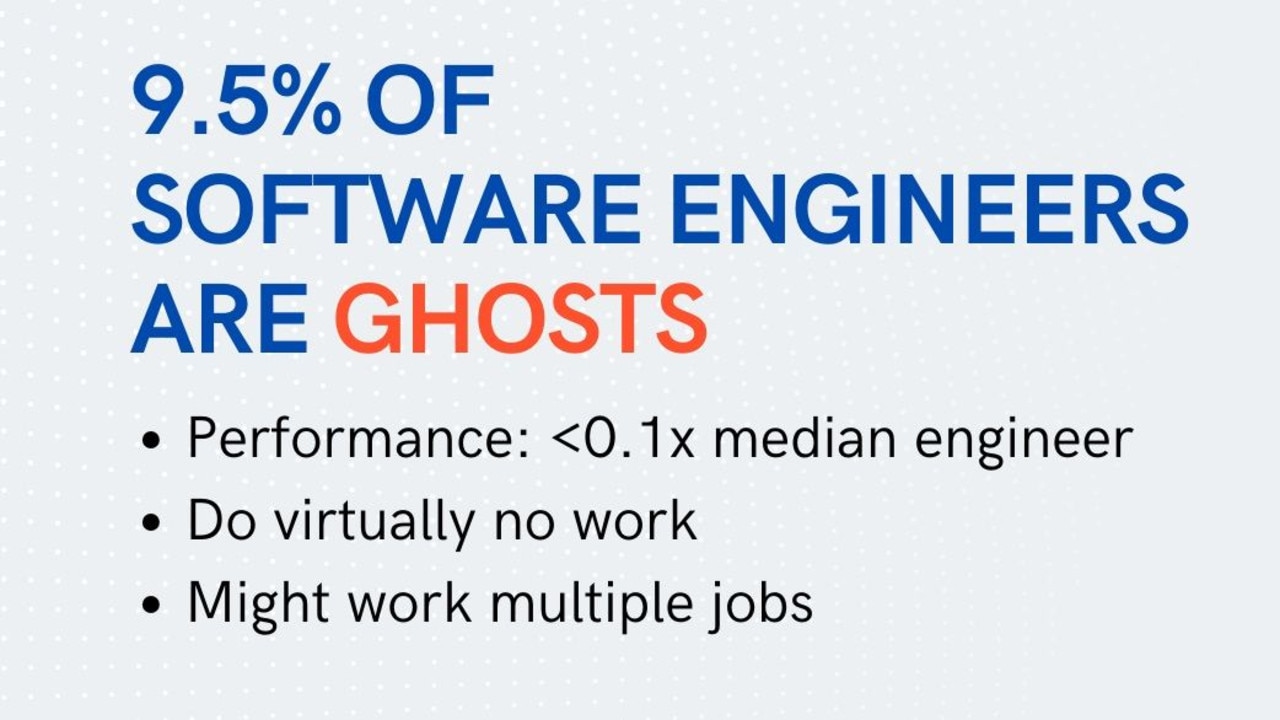‘Quiet quitting playbook’: The ghost workers getting paid to do ‘virtually nothing’
There is a popular industry that is apparently rife with “ghost workers”, with people reportedly getting paid between $200k – $300k to do “virtually nothing”.
An entire industry has been called out for apparently being riddled with ‘ghost workers’, who are reportedly taking home exorbitant pay cheques while producing very little work.
The revelation follows a new report from Stanford business school researcher, Yegor Denisov-Blanch, found a shocking number of engineers are doing “virtually nothing” on the job.
The 32-year-old graduate student, along with a team of researchers, analysed data on the performance of more than 50,000 engineers from hundreds of companies, finding that almost 10 per cent of workers were “ghosts”.
“9.5 per cent of software engineers do virtually nothing,” Mr Denisov-Blanch wrote on X.
He said that some in this group were contributing such little code that he suspected they may be working multiple jobs to boost their pay.

MORE: 5 signs your workplace is toxic – and what to do about it
The research, which has not been peer reviewed, found 14 per cent of software engineers working remotely do “almost no work”, compared to nine per cent in hybrid roles and six per cent in the office.
However, engineers were much more likely to work from home and more top performing employees worked remotely rather than in the office.
“Why does this matter? It’s insane that ~9.5 per cent of software engineers do almost nothing while collecting paychecks,” Mr Denisov-Blanch said.
“This unfairly burdens teams, wastes company resources, blocks jobs for others, and limits humanity’s progress. It has to stop.”
Mr Denisov-Blanch also estimated how much some major tech companies could save per year by getting rid of these “ghost workers”.
The researchers claimed IBM could save more than $2.5m, Microsoft more than $1.5m, Google $1.425m and Amazon over $1.1m.

MORE: The highest paying jobs in Australia without a degree
The Stanford researcher said the report was inspired by a post from Deedy Das, a tech influencer and former Google engineer.
Mr Das claimed there were many software engineers he knows personally earning between $200,000 and $300,000, all for making around two code changes per month, sending some emails, attending some meetings, working less than five hours per week.
“And no, AI is not writing their code. Most of these people are chilling so hard they have no idea what AI can do,” he wrote.
“Most people in tech were never surprised that Elon could lay off 80 per cent of Twitter, you can lay off 80 per cent of most of these companies.”
He claimed the “quiet quitting playbook” is well known by these employees, with many using different tricks to make it seem like they a busy while not doing anything.
These included things like having Slack show they are “in a meeting” so as not to appear inactive, scheduling emails and code changes for late hours, using a mouse jiggler and deliberately blowing out estimates for how long things will take to get done.
Mr Das went on to list 15 major companies he believes are being impacted by these ghost workers, including Oracle, Salesforce, Workday, IBM and Adobe.
Oracle
— Deedy (@deedydas) November 19, 2024
Salesforce
Cisco
Workday
SAP
IBM
VMware
Intuit
Autodesk
Veeva
Box
Citrix
Adobe
The post was later seen by Aaron Levie, CEO of Box, one of the companies named by Mr Das, with the CEO writing on X: “This has been a particularly constructive day”.
Speaking to The Washington Post, Mr Levie said that the post has sparked fresh conversations at his company about an issue they were already addressing, though no one had been immediately fired.
Mr Denisov-Blanch addressed some of the questions he had been getting since releasing the research in a follow up post on LinkedIn.
He claimed in many cases, the engineers identified as “ghosts” were focusing their efforts in other areas that would take up the majority of their time.
“There were engineers who did not directly contribute to the codebase, but were correctly identified to be contributing in other ways. These are not counted in the 9.5 per cent Ghost Engineer figure,” he said.
However, he did concede that, while the team strives for accuracy, there could be some false negatives or positives in the mix.
“There’s likely a self-selection bias in the 9.5 per cent of Ghost Engineers we identified. Organisations where something doesn’t feel right are more likely to want to participate in the research. Despite this, we have a large number of high-performing organisations as well,” he said.
“Even if we’re wrong by 50 per cent and there’s only 5 per cent of Ghost Engineers, it’s common knowledge that these folks exist. Check out Blind, Reddit, or any other communities. I have friends who are Ghosts, and they’re probably reading this.”
Ghost jobs also on the rise
On the flip side of this ghost worker revelation is the rise in ‘ghost jobs’, a trend that is being pushed by a surprising number of companies and one that is leaving job hunters frustrated.
A ghost job is essentially a fake job, where companies will post advertisements for positions that appear to be genuine but they actually have no intention of filling.
It’s a tactic that companies will use for various reasons, either to make themselves look better or achieve certain business agendas, and it’s more common than people realise.
Sue Parker previously owned her own recruitment agency and knows that posting fake jobs ads has been rife across Australia for decades.

Now a career and communications strategist at DARE Group Australia, Ms Parker previously told news.com.au recruiters and companies will often create ghost job ads in order to build their talent bank from the people who apply.
This ensures they have the resources to fill legitimate roles ASAP when they come through.
Another reason could be to give the appearance of being a “highly active and successful agency or business in their market”.
The idea is that if they are posting a lot of new job ads, then their business must be doing well to be able to support all these new roles.
“Fake job ads can also be posted to obtain market intelligence and information on competitors during the interview process,” Ms Parker said.
“The recruitment ecosystem is a pendulum. At times the pendulum swings towards a candidate market others towards a company/job market. Rarely is it in sync. So organisations and recruiters in quieter times can often use fake ads to bump up their activity.”
According to Ms Parker, there is never a situation where a recruiter or a company posting a fake job ad is justified.
“Ghost and fake job ads is a decision pure and simple to deceive and manipulate. It’s unethical and a form of candidate abuse,” she said.
“It causes reputation damage of brands and organisations, financial and time wastage for candidates.”
More Coverage
Originally published as ‘Quiet quitting playbook’: The ghost workers getting paid to do ‘virtually nothing’





